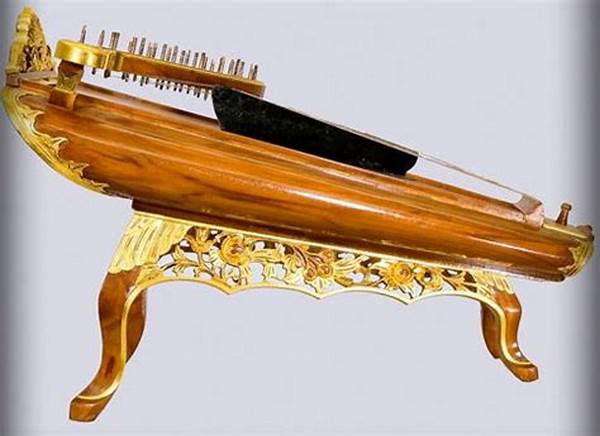In the bustling archipelago of Indonesia, where modernity and tradition dance in harmonious unison, a revival of sorts has emerged. The musical world is abuzz, captivated by the youthful energy breathing new life into a forgotten gem—the celempung. Often overshadowed by the flamboyance of the gamelan ensemble, the humble celempung, with its quiet dignity, is making a stunning comeback, orchestrated by the nation’s young artists.
Read More : Organ Musical Instrument That Shaped The Golden Era Of Church Music
This new wave of musicians, fueled by both passion and a fierce desire to preserve their cultural heritage, is not just orchestrating a revival; they are redefining what the celempung means for future generations. Wrapped in stories and dreams, their music echoes through Java’s hills, beckoning listeners to embark on a melodic journey that is at once nostalgic and innovative. Unique selling point? It’s raw, authentic, and distinctly Indonesian. But what makes the celempung’s revival even more intriguing is the blend of modern creativity with ancient tradition, creating a soundscape that is as educational as it is entertaining.
The Rising Trend of Celempung Among Young Artists
The cultural renaissance of the celempung is a testament to Indonesia’s vibrant artistic community. This resurgence isn’t only about preserving an ancient instrument; it’s about reclaiming cultural identity in an era increasingly dominated by western influences. Through dedicated effort and innovative approaches, these young artists are spotlighting the celempung’s versatility, adapting its hauntingly beautiful sounds across a myriad of music genres.
Statistics suggest a significant increase in the number of young Indonesians engaging with traditional music forms. Interviews reveal that many artists are drawn to the celempung’s unique tonality and its ability to convey deep emotional narratives. In this journey of rediscovery, they are not just performers but storytellers, each strum resonating with personal and cultural significance. The journey, however, is not solitary. It involves community gatherings, workshops, and an ever-growing network that is passionately engaged in this musical revival.
Celempung’s Historical Context and Modern Relevance
To appreciate the present fervor surrounding the celempung, one must delve into its rich history. Traditionally part of the gamelan ensemble, the celempung adds a distinctive texture with its stringed resonance, playing a critical role in the tonal fabric of Javanese music. The instrument has, however, faced challenges in staying relevant, often relegated to ceremonial performances and academic study.
Yet, in marrying tradition with innovation, today’s young musicians are proving that the celempung’s relevance transcends time. By incorporating modern elements into their performances, they showcase the instrument’s adaptability, whether it’s echoing the soulful strains of a pop ballad or providing rhythm to a raucous jazz fusion. This cross-genre application not only revitalizes the celempung but also introduces it to a global audience eager for fresh sounds steeped in history.
How Young Artists Are Innovating with Celempung
The Future of Celempung in Indonesian Music
While the celempung’s resurgence is heartening, what does the future hold? For one, the celempung’s revival signifies a larger movement of cultural appreciation and preservation that is taking root among the youth. Through initiatives supported by cultural organizations and enthusiastic patrons, the celempung is not only poised to remain relevant but might also redefine the landscape of Indonesian traditional music.
Read More : Name A Musical Instrument Featured In National Anthems Globally
Educational Impact of Celempung Revival
The celempung’s revival is awakening curiosity and prompting educational reforms within arts curricula across Indonesian schools. By making traditional music education accessible and engaging, children aren’t just learning to play an instrument; they’re absorbing valuable cultural lessons. Young artists often share stories of how their engagement with the celempung gave them a deeper understanding of their heritage, reinforcing its importance in personal and national identity.
Cultural and Emotional Connectivity
On an emotional level, the celempung offers listeners an escape into another world, encouraging a connection with Indonesia’s diverse cultural tapestry. For young artists, it presents a platform to express their unique identities and stories through music. The instruments’ soulful sounds act as an unspoken language, transcending barriers and inviting listeners, both young and old, to experience the depths of Javanese tradition.
The Power of Storytelling and Community Engagement
Community plays a pivotal role; through storytelling and shared performances, the celempung becomes a focal point that brings people together. Whether through small village gatherings or large international showcases, the power of the celempung lies in its ability to unite, inspire, and evoke profound emotional reactions. Each performance is a narrative, intricately weaving together the past, present, and future in harmonious synchrony.
In conclusion, as young artists continue to champion this revival, their efforts highlight an essential truth: the beauty of tradition not only anchors us to our roots but also propels us forward, inviting creativity and innovation. The indonesia traditional music instrument celempung revived by young artists is a testament to the enduring power of cultural heritage, reborn in the hands of a new generation.
